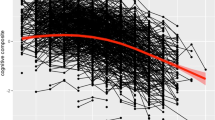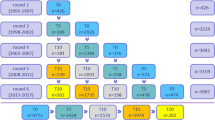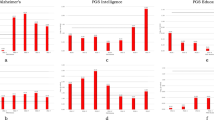Abstract
Several genetic polymorphisms have been associated with Late Onset Alzheimer’s Disease (LOAD), but there has been limited evidence on whether these polymorphisms predict intermediary stage outcomes such as cognitive changes in prospective community-based studies. Our aim was to evaluate whether polymorphisms previously established as predictors of LOAD also predict worse cognitive function and accelerated decline across multiple cognitive domains. We analyzed data from the 3C-Dijon study, in which 4931 respondents aged 65+ were examined up to 5 times over 10 years with a neuropsychological assessment. We evaluated the associations of polymorphisms in APOE, CR1, BIN1, CLU, PICALM, ABCA7, MS4A6A, CD33, MS4A4E and CD2AP with level and change in 5 neuropsychological tests, assuming a dominant effect model. To optimize measurement, we used a mixed regression model with a latent process for each cognitive domain: global cognition (Mini Mental State Examination); verbal fluency (Isaac’s Set Test); visual memory (Benton Visual Retention Test); information processing (Trail Making Test B) and literacy (National Adult Reading Test). APOE was associated with accelerated decline in global cognition and verbal fluency. Only two non-APOE genetic polymorphisms were associated with cognitive decline: CR1 was associated with rate of change in verbal fluency and BIN1 was associated with rate of change in global cognition. In a large prospective population-based study of dementia-free individuals, only a few cognitive domains were associated with established LOAD risk alleles. The most consistent associations were for global cognition and verbal fluency.
This is a preview of subscription content, access via your institution
Access options
Subscribe to this journal
Receive 12 print issues and online access
$259.00 per year
only $21.58 per issue
Buy this article
- Purchase on Springer Link
- Instant access to full article PDF
Prices may be subject to local taxes which are calculated during checkout
Similar content being viewed by others
References
Lambert JC, Heath S, Even G, Campion D, Sleegers K, Hiltunen M et al. Genome-wide association study identifies variants at CLU and CR1 associated with Alzheimer's disease. Nat Genet 2009; 41: 1094–1099.
Bertram L, McQueen MB, Mullin K, Blacker D, Tanzi RE . Systematic meta-analyses of Alzheimer disease genetic association studies: the AlzGene database. Nat Genet 2007; 39: 17–23.
Harold D, Abraham R, Hollingworth P, Sims R, Gerrish A, Hamshere ML et al. Genome-wide association study identifies variants at CLU and PICALM associated with Alzheimer's disease. Nat Genet 2009; 41: 1088–1093.
Seshadri S, Fitzpatrick AL, Ikram MA, DeStefano AL, Gudnason V, Boada M et al. Genome-wide analysis of genetic loci associated with Alzheimer disease. JAMA 2010; 303: 1832–1840.
Naj AC, Jun G, Beecham GW, Wang LS, Vardarajan BN, Buros J et al. Common variants at MS4A4/MS4A6E, CD2AP, CD33 and EPHA1 are associated with late-onset Alzheimer's disease. Nat Genet 2011; 43: 436–441.
Jun G, Naj AC, Beecham GW, Wang LS, Buros J, Gallins PJ et al. Meta-analysis confirms CR1, CLU, and PICALM as alzheimer disease risk loci and reveals interactions with APOE genotypes. Arch Neurol 2010; 67: 1473–1484.
Hollingworth P, Harold D, Sims R, Gerrish A, Lambert JC, Carrasquillo MM et al. Common variants at ABCA7, MS4A6A/MS4A4E, EPHA1, CD33 and CD2AP are associated with Alzheimer's disease. Nat Genet 2011; 43: 429–435.
Morgan K . The three new pathways leading to Alzheimer's disease. Neuropathol Appl Neurobiol 2011; 37: 353–357.
Caselli RJ, Dueck AC, Osborne D, Sabbagh MN, Connor DJ, Ahern GL et al. Longitudinal modeling of age-related memory decline and the APOE epsilon4 effect. N Engl J Med 2009; 361: 255–263.
Small BJ, Rosnick CB, Fratiglioni L, Backman L, Apolipoprotein E . and cognitive performance: a meta-analysis. Psychol Aging 2004; 19: 592–600.
Anstey K, Christensen H . Education, activity, health, blood pressure and apolipoprotein E as predictors of cognitive change in old age: a review. Gerontology 2000; 46: 163–177.
Hamilton G, Harris SE, Davies G, Liewald DC, Tenesa A, Starr JM et al. Alzheimer's disease genes are associated with measures of cognitive ageing in the lothian birth cohorts of 1921 and 1936. Int J Alzheimers' Dis 2011; 2011: 505984.
Chibnik LB, Shulman JM, Leurgans SE, Schneider JA, Wilson RS, Tran D et al. CR1 is associated with amyloid plaque burden and age-related cognitive decline. Ann Neurol 2011; 69: 560–569.
Verhaaren BF, Vernooij MW, Koudstaal PJ, Uitterlinden AG, van Duijn CM, Hofman A et al. Alzheimer's disease genes and cognition in the nondemented general population. Biol Psychiatry 2013; 73: 429–434.
Barral S, Bird T, Goate A, Farlow MR, Diaz-Arrastia R, Bennett DA et al. Genotype patterns at PICALM, CR1, BIN1, CLU, and APOE genes are associated with episodic memory. Neurology 2012; 78: 1464–1471.
Sweet RA, Seltman H, Emanuel JE, Lopez OL, Becker JT, Bis JC et al. Effect of Alzheimer's disease risk genes on trajectories of cognitive function in the Cardiovascular Health Study. Am J Psychiatry 2012; 169: 954–962.
The 3C Study Group. Vascular factors and risk of dementia: design of the Three-City Study and baseline characteristics of the study population. Neuroepidemiology 2003; 22: 316–325.
Folstein MF, Folstein SE, McHugh PR . "Mini-mental state". A practical method for grading the cognitive state of patients for the clinician. J Psychiatr Res 1975; 12: 189–198.
Isaacs B, Kennie AT . The Set-Test as an aid to the detection of dementia in old people. Br J Psychiatry 1973; 45: 957–962.
Blair JR, Spreen O . Predicting premorbid IQ: a revision of the National Adult Reading Test. Clin Neuropsychol 1989; 3: 129–136.
Reitan RM . Validity of the Trail Making Test as an indicator of organic brain damage. Percept Mot Skills 1965; 8: 271–276.
Benton AL . Manuel pour l'Application du test de Retention Visuelle. Applications Cliniques et Experimentales, vol. 2nd. Centre de Psychologie Appliquée: Paris 1965.
DePaulo JR, Folstein MF, Gordon B . Psychiatric screening on a neurological ward. Psychol Med 1980; 10: 125–132.
Tombaugh TN, McIntyre NJ . The mini-mental state examination: a comprehensive review. J Am Geriatr Soc 1992; 40: 922–935.
Amieva H, Jacqmin-Gadda H, Orgogozo JM, Le Carret N, Helmer C, Letenneur L et al. The 9 year cognitive decline before dementia of the Alzheimer type: a prospective population-based study. Brain 2005; 128: 1093–1101.
Dick JP, Guiloff RJ, Stewart A, Blackstock J, Bielawska C, Paul EA et al. Mini-mental state examination in neurological patients. J Neurol Neurosurg Psychiatry 1984; 47: 496–499.
Isaacs B, Kennie AT . The Set test as an aid to the detection of dementia in old people. Br J Psychiatry 1973; 123: 467–470.
Proust-Lima C, Amieva H, Dartigues JF, Jacqmin-Gadda H . Sensitivity of four psychometric tests to measure cognitive changes in brain aging-population-based studies. Am J Epidemiol 2007; 165: 344–350.
Koch W, Ehrenhaft A, Griesser K, Pfeufer A, Muller J, Schomig A et al. TaqMan systems for genotyping of disease-related polymorphisms present in the gene encoding apolipoprotein E. Clin Chem Lab Med 2002; 40: 1123–1131.
Proust C, Jacqmin-Gadda H, Taylor JM, Ganiayre J, Commenges D . A nonlinear model with latent process for cognitive evolution using multivariate longitudinal data. Biometrics 2006; 62: 1014–1024.
Proust-Lima C, Dartigues JF, Jacqmin-Gadda H . Misuse of the linear mixed model when evaluating risk factors of cognitive decline. Am J Epidemiol 2011; 174: 1077–1088.
Chibnik LB, Shulman JM, Leurgans SE, Schneider JA, Wilson RS, Tran D et al. CR1 is associated with amyloid plaque burden and age-related cognitive decline. Ann Neurol 2011; 69: 560–569.
Keenan BT, Shulman JM, Chibnik LB, Raj T, Tran D, Sabuncu MR et al. A coding variant in CR1 interacts with APOE-ɛ4 to influence cognitive decline. Hum Mol Genet 2012; 21: 2377–2388.
Mengel-From J, Thinggaard M, Lindahl-Jacobsen R, McGue M, Christensen K, Christiansen L . CLU genetic variants and cognitive decline among elderly and oldest old. PLoS One 2013; 8: e79105.
Pedraza O, Allen M, Jennette K, Carrasquillo M, Crook J, Serie D et al. Evaluation of memory endophenotypes for association with CLU, CR1, and PICALM variants in black and white subjects. Alzheimers Dement 2014; 10: 205–213.
Thambisetty M, Beason-Held LL, An Y, Kraut M, Nalls M, Hernandez DG et al. Alzheimer risk variant CLU and brain function during aging. Biol Psychiatry 2013; 73: 399–405.
Hamilton G, Harris SE, Davies G, Liewald DC, Tenesa A, Starr JM et al. Alzheimer's disease genes are associated with measures of cognitive ageing in the lothian birth cohorts of 1921 and 1936. Int J Alzheimers Dis 2011 2011; 505984.
Harris SE, Davies G, Luciano M, Payton A, Fox HC, Haggarty P et al. Polygenic risk for alzheimer's disease is not associated with cognitive ability or cognitive aging in non-demented older people. J Alzheimers Dis 2014; 39: 565–574.
Anthony JC, LeResche L, Niaz U, von Korff MR, Folstein MF . Limits of the 'Mini-Mental State' as a screening test for dementia and delirium among hospital patients. Psychol Med 1982; 12: 397–408.
McGurn B, Starr JM, Topfer JA, Pattie A, Whiteman MC, Lemmon HA et al. Pronunciation of irregular words is preserved in dementia, validating premorbid IQ estimation. Neurology 2004; 62: 1184–1186.
Acknowledgements
Institut National de la Santé et de la Recherche Médicale (INSERM), the Victor Segalen-Bordeaux II University, Fondation Plan Alzheimer, the Sanofi-Synthélabo Company, Fondation pour la Recherche Médicale, Caisse Nationale Maladie des Travailleurs Salariés, Direction Générale de la Santé, Haute Autorité de la Santé, Institut National de Prévention et d'Education pour la Santé (INPES), Conseils Régionaux of Bourgogne, Fondation de France, the Ministry of Research-INSERM Program 'Cohortes et collections de données biologiques', Mutuelle Générale de l'Education Nationale, Institut de la Longévité and Conseil Général de la Côte d'or. Maria Glymour received support from the National Institute on Aging (AG034385). We thank the study participants and the 3C-Dijon team (coordinators, psychometrists, psychologists, program management team, and physicians) for their help in conducting this study.
Author information
Authors and Affiliations
Corresponding author
Ethics declarations
Competing interests
The authors declare no conflict of interest.
Additional information
Disclaimer
The funding sources had no role in the design and conduct of the study; collection, management, analysis and interpretation of the data; preparation, review or approval of the manuscript; and decision to submit the manuscript for publication.
Rights and permissions
About this article
Cite this article
Vivot, A., Glymour, M., Tzourio, C. et al. Association of Alzheimer’s related genotypes with cognitive decline in multiple domains: results from the Three-City Dijon study. Mol Psychiatry 20, 1173–1178 (2015). https://doi.org/10.1038/mp.2015.62
Received:
Revised:
Accepted:
Published:
Issue Date:
DOI: https://doi.org/10.1038/mp.2015.62
This article is cited by
-
Associations of genetic liability for Alzheimer’s disease with cognition and eye movements in a large, population-based cohort study
Translational Psychiatry (2022)
-
The role of ABCA7 in Alzheimer’s disease: evidence from genomics, transcriptomics and methylomics
Acta Neuropathologica (2019)
-
The BIN1 rs744373 SNP is associated with increased tau-PET levels and impaired memory
Nature Communications (2019)



